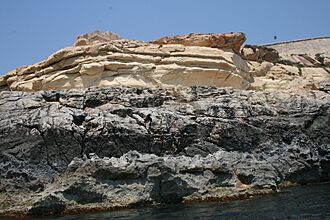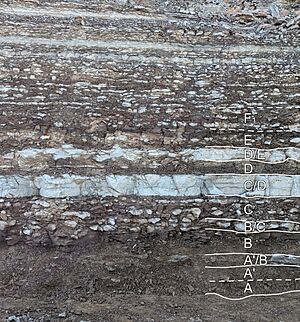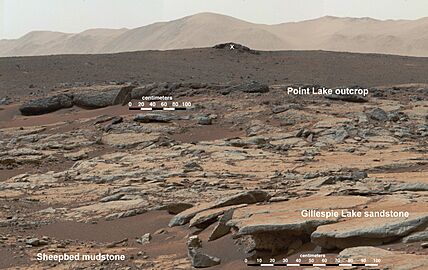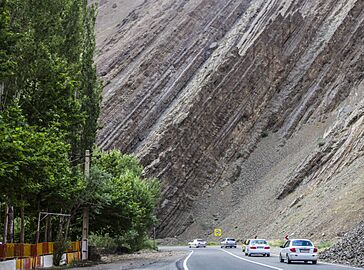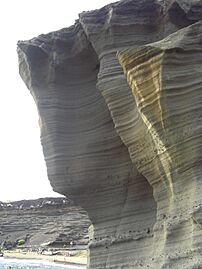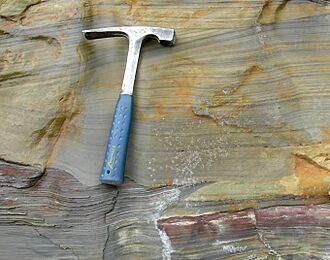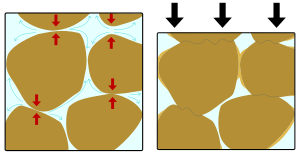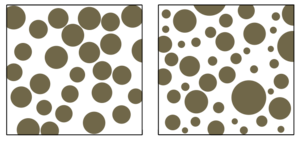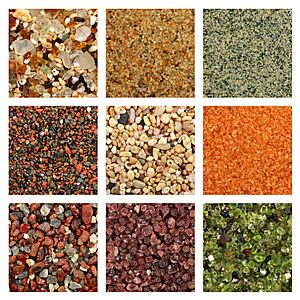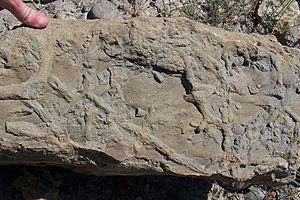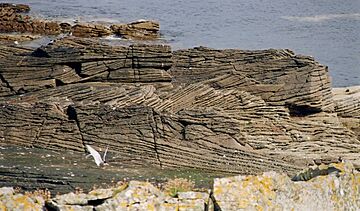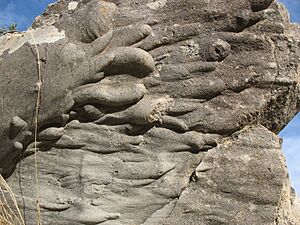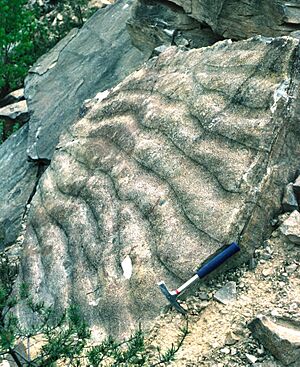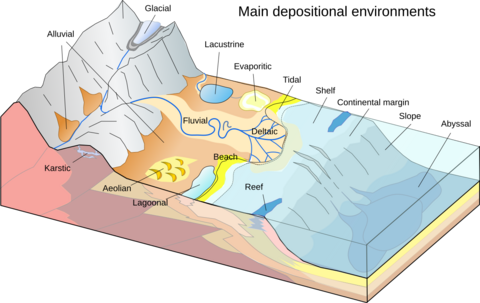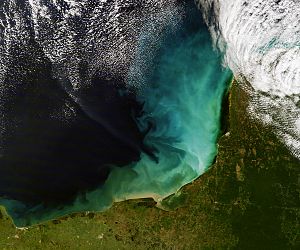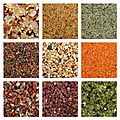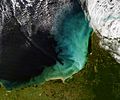Sedimentary rock facts for kids
Sedimentary rocks are types of rock that form from tiny pieces of other rocks, minerals, or even living things. These pieces, called sediments, gather together and are then glued, or cemented, into solid rock. This process often happens on Earth's surface.
Sediments can come from different places. Some are bits of older rocks broken down by weathering and erosion. These bits are carried by water, wind, ice, or landslides to new locations. Other sediments come from dead aquatic organisms, like shells or tiny bits of plants, that settle at the bottom of oceans or lakes. Sometimes, minerals dissolved in water can also form sedimentary rocks when they solidify.
Sedimentary rocks cover about 73% of Earth's land surface. However, they make up only a small part (about 8%) of the Earth's crust by volume. They usually form thin layers over much larger amounts of igneous and metamorphic rocks. These layers are called strata or beds. Scientists have even found sedimentary rocks on Mars!
Studying these rocks helps engineers build roads, houses, and tunnels safely. Sedimentary rocks are also important sources of natural resources. These include coal, fossil fuels like oil and natural gas, drinking water, and valuable ores.
By looking at the layers of sedimentary rocks, scientists can learn about Earth's past. This includes what the land and climate were like long ago, and how life on Earth changed over time. The study of sedimentary rocks is called sedimentology.
Contents
How Sedimentary Rocks Form
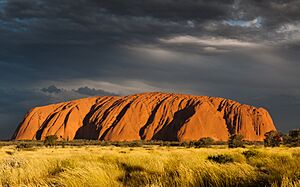
Sedimentary rocks are grouped into four main types based on how they form:
Clastic Sedimentary Rocks
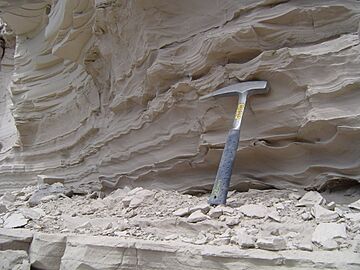
Clastic rocks are made from pieces of other rocks, called clasts, that have been cemented together. These clasts can be tiny grains of quartz, feldspar, or clay minerals. They can also be larger fragments made of several minerals.
Scientists classify clastic rocks by the size of their particles:
- Gravel is larger than 2 millimeters (like small pebbles).
- Sand is between 0.06 and 2 millimeters.
- Mud is smaller than 0.06 millimeters. Mud is further divided into silt and clay.
Based on these sizes:
- Conglomerates and breccias are mostly made of gravel.
- Sandstones are mostly made of sand.
- Mudrocks are mostly made of mud.
Conglomerates and Breccias
Breccias have sharp, angular gravel pieces. Conglomerates have rounded gravel pieces, like pebbles smoothed by a river.
Sandstones
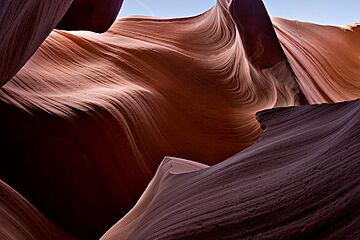
Sandstones are classified by what their sand grains are made of and how much muddy material is mixed in.
- Quartz sandstones have more than 90% quartz grains.
- Feldspathic sandstones have less quartz and more feldspar than other rock pieces.
- Lithic sandstones have less quartz and more pieces of other rocks than feldspar.
Also, sandstones can be:
- Arenites: These are "clean" sandstones with little to no mud between the sand grains.
- Wackes: These are muddy sandstones with more than 10% mud between the sand grains.
So, you can have names like "quartz arenite" (mostly quartz, little mud) or "lithic wacke" (lots of rock pieces, lots of mud).
Mudrocks
Mudrocks are made of at least 50% silt and clay particles. These tiny particles are carried by water or air and settle when the flow slows down.
Mudrocks include:
- Siltstones: Mostly silt-sized particles.
- Mudstones: A mix of silt and clay.
- Claystones: Mostly clay-sized particles.
- Shale: A mudrock that easily splits into thin layers.
Biochemical Sedimentary Rocks
These rocks form when living things use minerals from water or air to build their bodies.
- Most limestones come from the shells and skeletons of sea creatures like corals and mollusks.
- Coal forms from ancient plants that took carbon from the air. When these plants die and are buried, they get compressed and change into coal.
- Chert forms from the tiny silica skeletons of microscopic organisms like radiolaria and diatoms.
Chemical Sedimentary Rocks
These rocks form when minerals dissolved in water become too concentrated and solidify.
- Examples include oolitic limestone and rocks made of evaporite minerals. Evaporites form when water evaporates, leaving minerals behind. Common evaporites are halite (rock salt) and gypsum.
Other Sedimentary Rocks
This group includes rocks formed by special events:
- Volcanic tuff and volcanic breccias form from volcanic ash and lava fragments.
- Impact breccias form from debris after meteorites hit Earth.
-
Sedimentary rocks on Mars, studied by the Curiosity Mars rover.
What Sedimentary Rocks Are Made Of
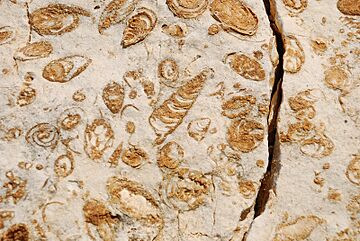
Sedimentary rocks can also be grouped by their main mineral content:
- Siliciclastic rocks are mostly made of silicate minerals, like quartz. These include conglomerates, sandstones, and mudrocks.
- Carbonate rocks are made of carbonate minerals like calcite and dolomite. Limestone is a common example.
- Evaporite rocks form when water evaporates, leaving minerals behind. They often contain halite (rock salt) or gypsum.
- Organic-rich sedimentary rocks have a lot of organic material (more than 3%). Coal and oil shale are examples.
- Siliceous rocks are almost entirely made of silica, often as chert or opal.
- Iron-rich sedimentary rocks contain more than 15% iron. Banded iron formations are a good example.
- Phosphatic rocks contain phosphate minerals and more than 6.5% phosphorus.
How Sediments Become Rock
Sediment Transport and Deposition
Sedimentary rocks begin when loose material, called sediment, settles out of air, ice, wind, or water. This sediment often comes from older rocks that have been broken down by weathering and erosion. The type of sediment depends on the rocks in the source area. Some sedimentary rocks, like evaporites, form right where they are deposited. So, the final rock depends on both the sediment supply and the environment where it settled.
Transformation (Diagenesis)
As sediments pile up, older layers get buried deeper. This burial causes many changes, known as diagenesis. This includes all the chemical, physical, and biological changes that happen to sediment after it's first laid down.
One key change is compaction. The weight of new sediments presses down on older ones. This squeezes the grains closer together and pushes out water.
Another important change is lithification. As temperatures rise with depth, minerals dissolved in the water can solidify between the grains, acting like glue. This process, called cementation, binds the loose sediments into solid rock. For example, loose sand becomes hard sandstone.
Sometimes, buried sedimentary rocks are later brought closer to the surface by erosion. This can cause further changes, like some of the cement dissolving away.
If the temperature and pressure get too high, the rock can change into a metamorphic rock.
Rock Characteristics
Color
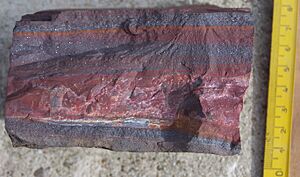
The color of a sedimentary rock often comes from iron.
- If there's little oxygen, iron forms iron(II) oxide, making the rock grey or greenish.
- With more oxygen, iron forms iron(III) oxide (like the mineral hematite), giving the rock a reddish or brownish color. Red rocks formed in dry climates are called red beds.
Dark grey or black colors usually mean the rock contains a lot of organic material (from dead plants and animals). This happens when there isn't enough oxygen for the material to decay, like at the bottom of deep lakes or seas.
Texture
The texture of a sedimentary rock describes the size, shape, and arrangement of its clasts (rock pieces). Texture affects properties like how dense or porous the rock is.
- Grain size tells us how big the particles are. Fast-moving water carries larger particles like gravel, while calm water only carries fine mud.
- Sorting describes how uniform the grain sizes are. A "well-sorted" rock has grains all about the same size. A "poorly sorted" rock has a mix of large and small grains.
- Rounding describes how smooth or angular the grains are. Grains that have traveled far in water or wind tend to be more rounded.
- Sphericity describes how close a grain's shape is to a perfect sphere.
Chemical sedimentary rocks, which form from crystals, have a different texture. We describe them by the average size and arrangement of their crystals.
Mineralogy
Most sedimentary rocks are rich in either quartz (siliciclastic rocks) or calcite (carbonate rocks). Unlike igneous rocks, sedimentary rocks usually have fewer main minerals. The minerals can be original sediment pieces or new minerals that formed during diagenesis.
Minerals like quartz are very stable and resist weathering. Others, like feldspar and mica, break down more easily into clay minerals over time.
Fossils
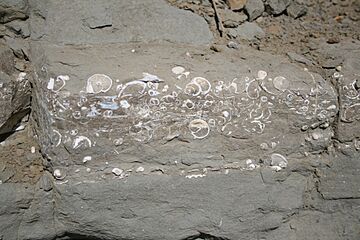
Fossils are most commonly found in sedimentary rocks. This is because sedimentary rocks form at temperatures and pressures that don't destroy the remains of ancient plants and animals.
Fossilization happens when dead organisms are quickly buried, protecting them from decay. Organisms with hard parts like bones or shells are more likely to become fossils. Sometimes, soft tissues can be preserved if conditions are just right.
- Trace fossils are signs of an organism's activity, like burrows or footprints, rather than the organism itself.
- Permineralization occurs when minerals fill the empty spaces in an organism's remains, preserving its shape.
- Carbonization happens when organic material is compressed, leaving behind a thin film of pure carbon, often seen in plant fossils. This process also forms coal.
Primary Sedimentary Structures
Primary structures form during the deposition of sediments. They can tell us about the ancient environment.
- Bedding refers to the layers, or beds, that sedimentary rocks form in. Each bed has a similar type of rock and texture. Thinner layers are called laminae.
- Cross-bedding happens when layers are deposited at an angle, often by wind or water currents. It's common in sand dunes or riverbeds.
- Parallel lamination means all layers are flat and parallel.
- Graded bedding is when larger grains are at the bottom of a layer and smaller grains are at the top. This forms when fast-moving water suddenly slows down.
- Ripple marks are wavy patterns on the surface of a bed, like those you see on a sandy beach. They can be symmetric (from back-and-forth currents) or asymmetric (from one-way currents).
- Mudcracks are polygonal cracks that form when wet mud dries and shrinks. They show that the sediment was exposed to air.
Secondary Sedimentary Structures
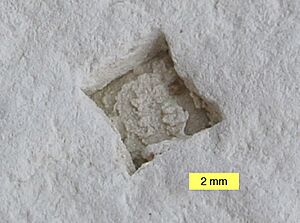
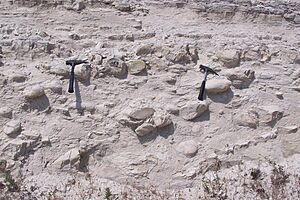
Secondary structures form after sediments are deposited, due to chemical, physical, or biological changes.
- Bioturbation is when organisms like worms or crustaceans burrow through sediment, leaving behind trace fossils. This activity can mix up the sediment.
- Concretions are hard, rounded lumps of minerals that grow within sedimentary rock. They form when minerals precipitate around a central point, like a fossil or a plant root.
- Mud volcanoes and sedimentary dykes can form when wet sand or mud is squeezed upwards through overlying layers.
Where Sedimentary Rocks Form
The place where a sedimentary rock forms is called its depositional environment. Each environment has unique conditions that affect the type of sediment deposited.
- Marine environments are in the sea or ocean.
* Shallow marine areas (near coastlines) have more wave action, so they can transport coarser sediments like sand. In warm, shallow waters, many organisms with carbonate shells live, leading to the formation of limestone. * Deep marine areas (far from shore) have calmer water. Only fine particles like clay or tiny skeletons of microorganisms settle here. Below a certain depth, carbonate shells dissolve, so rocks like radiolarite (made of silica skeletons) are common.
- Coastal environments are shaped by waves and tides.
* Beaches have sand and gravel. * Tidal flats sometimes dry out with the tides. * Deltas form where rivers meet the sea or a lake, depositing large amounts of sediment.
- Continental environments are found inland.
* Lakes, swamps, and lagoons have calm water where fine sediment and organic material collect. * Rivers carry heavier clastic material. * Aeolian (wind-blown) deposits, like sand dunes, are usually very well sorted. * Glacial till is sediment carried by glaciers, which is usually poorly sorted (a mix of all sizes).
Sedimentary Facies
The type of rock formed in a specific depositional environment is called its sedimentary facies. Different environments exist side-by-side. For example, a beach (sand and gravel) might be next to a deeper marine area (finer sediments).
Over long periods, these environments can shift.
- Transgression is when the sea level rises, and deeper marine environments move over shallower ones.
- Regression is when the sea level drops, and shallower environments move over deeper ones.
By mapping these facies from different times, scientists can reconstruct ancient geographies.
Sedimentary Basins
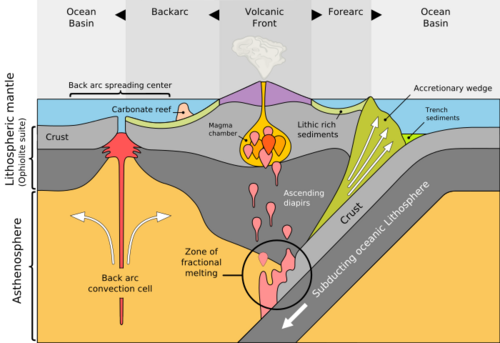
Large areas where a lot of sediment collects are called sedimentary basins. The size and depth of a basin depend on tectonics, which are movements in Earth's outer layer. When the Earth's crust moves down, a basin forms, and sediments can pile up. When it moves up, land rises, and erosion removes material.
- Rift basins form when parts of a continent pull apart, creating long, deep valleys that fill with sediment and volcanic rocks.
- Sag basins form when a part of the crust cools and sinks, allowing huge amounts of sediment to accumulate, sometimes over 10 kilometers thick!
- Fore-arc basins and foreland basins form near plate boundaries where one plate slides under another. These basins fill with thick layers of deep marine sediments and eroded material from rising mountain ranges.
- Back-arc basins form on the other side of a mountain range, often filled with shallow marine sediments.
Influence of Astronomical Cycles
Many changes in sedimentary rocks happen in cycles. These cycles are often caused by astronomical events. For example, small changes in Earth's orbit and tilt (called Milankovitch cycles) can affect climate and sea level over thousands of years. These climate changes then influence how much sediment is supplied and where it's deposited, leading to cyclic patterns in the rocks.
Sedimentation Rates
Sedimentation rates vary greatly. A river channel might deposit meters of sediment in a day, while the deep ocean floor might only get a few millimeters a year. Sometimes, sudden events like landslides or floods can deposit huge amounts of sediment very quickly. In other places, sedimentation is a slow, ongoing process.
Stratigraphy
Sedimentary rocks are laid down in layers, or strata. The principle of superposition states that in undisturbed layers, the oldest layers are at the bottom, and the newest layers are at the top.
Sometimes there are gaps in these layers, called unconformities. These gaps mean that either no new sediments were deposited for a long time, or older layers were lifted up and eroded away.
- Angular unconformity is when older, tilted layers are covered by newer, horizontal layers.
- Nonconformity is when sedimentary layers are on top of igneous or metamorphic rocks.
- Disconformity is when parallel layers are separated by an erosion surface.
Sedimentary rocks hold important clues about Earth's past, including ancient climates, environments, and the history of life through their fossil content.
Provenance
Provenance is the study of where sediments came from. All rocks on Earth's surface break down into sediment. By studying these sediments, scientists can figure out what the original source rocks were and how the sediment traveled to its final resting place.
Related pages
Images for kids
-
Uluru (Ayers Rock) is a large sandstone formation in Northern Territory, Australia.
-
Claystone deposited in Glacial Lake Missoula, Montana, United States.
-
Sedimentary rock with sandstone in Malta.
-
Lower Antelope Canyon carved from sandstone by wind, sand, and water.
-
Outcrop of Ordovician oil shale (kukersite), northern Estonia.
-
Fossils of Nerinea marine gastropods of Late Cretaceous age, in limestone in Lebanon.
-
Cross-bedding and scour in fine sandstone; Logan Formation (Mississippian) of Jackson County, Ohio.
-
A piece of a banded iron formation, with alternating layers of iron oxides.
-
Cross-bedding in fluviatile sandstone, Middle Old Red Sandstone (Devonian) on Bressay, Shetland Islands.
-
Sediment in the shallow waters of the Gulf of Mexico off the Yucatan Peninsula.
-
Layers of rock in the Blue Lias at Lyme Regis, southern England.
-
The Permian through Jurassic layers of the Colorado Plateau in southeastern Utah.
-
Sedimentary rocks on Mars, investigated by NASA's Curiosity Mars rover.
See also
 In Spanish: Roca sedimentaria para niños
In Spanish: Roca sedimentaria para niños



